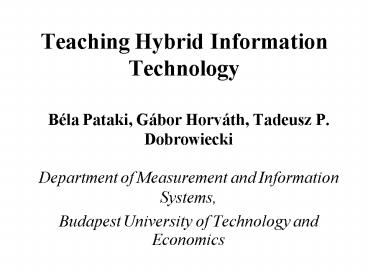Teaching Hybrid Information Technology PowerPoint PPT Presentation
1 / 10
Title: Teaching Hybrid Information Technology
1
Teaching Hybrid Information Technology
- Béla Pataki, Gábor Horváth, Tadeusz P.
Dobrowiecki - Department of Measurement and Information
Systems, - Budapest University of Technology and Economics
2
Content Why ? How ? What
? Experience ?
3
Why ? Complementary character of the empirical
and symbolic (domain theoretic)
approaches Symbolic approach Empirical
approach knowledge acquisition
difficult automated knowledge
acquisition through learning expert
systems can degrade neural networks degrade
quickly (are brittle) when being gracefully,
easy fault tolerant at their limits operation
higher and lower-level reasoning easy and
almost impossible the same is true for any kind
of explanation generating facility
4
Why ? Complementary character of the empirical
and symbolic (domain theoretic)
approaches Symbolic approach Empirical
approach explanation based learning empirical
(neural) learning (based on domain theory)
requires almost no theory needs no empirical
data, numerous empirical requires
precise, complete data domain theory no
problems with considerable problems
with exception handling, exception
handling, context handling context
handling, abstraction. abstraction.
5
Why ? Complementary character of the empirical
and symbolic (domain theoretic) approaches -
real life always a bit of theory and a bit of
empirical data present, - amplification of the
advantages ? integration of approaches, Hybrid
information processing one of the most
important topics in the nowadays information
technology. Why ? (1) way of 'improving' the
traditional problem solving methods, (2) complex
problems are inherently hybrid it is usually
impossible to represent and to solve the
problem in a homogenous and simple
way, (3) multi-functionality, i.e. embedding
more information processing capability
within a single architecture.
6
An Example KBANN - Knowledge-Based
Artificial Neural Networks
7
How ? The Framework Intelligent Systems
Module
7th Semester Artificial Intelligence Basics
Lab Fuzzy Systems and Genetic Algorithms Knowled
ge-based Architectures 8th Semester
HW Hybrid Information Technology Symbolic
Signal Processing and Soft Computing Lab 9th
Semester HW 3-D Vision
Systems Hybrid Systems and 3-D Picture
Processing Lab Project Lab
8
The sketch of the curriculum -Hybrid Approach -
Why How -neural network embedded tools -Modular
neural networks - linear composition of
networks, Mixture of Experts, modularization
by task decomposition (CMMN). -Embedding
rules into networks, extracting rules from
networks ART, fuzzy ART, fuzzy ARTMAP, CASCADE
ARTMAP. VIA and TREPAN algorithm. -OSF
filters -Neural networks with fuzzy numbers,
completely fuzzified networks General Fuzzy
Perceptron (NEFCON, NEFPROX, ...) -KBANN -
Knowledge-Based Artificial Neural Networks,
-Anytime KBANN, TOPGEN (Topology Generator),
REGENT (GA-tuned KBANN). FSKBANN Finite State
KBANN, Reinforcement learning with advises -
RATLE approach
9
Some of the recent homework topics Prediction
of Time Series Chaotic System, Solar Activity
(Sun Spots), Stock Values, Chaotic Components of
the ECG Expert System for PC Configuring, ECG
Diagnostics, Intelligent Programs Playing Card
Games, Speech Recognition System, Person
Identification System Independent Component
Decomposition, Map Coloring, Car Parking, IQ Test
Solver, Intelligent Information Search on the
Web, Investigation of the Searching
Algorithms Implementation of the Cascade
Correlation Network, Hierarchic Mixture of
Experts Network, Cooperative Modular Neural
Network, Neural Order Statistic Filter, Neural
Network suitable to operate on fuzzy data Rule
Extraction from the network with the VIA
algorithm, by the way of decision trees, with the
implemented cascade ARTMAP system, with the
SUBSET algorithm Experimental implementation of
the REGENT system, FSKBANN system, the RATLE
system
10
Experience - teaching hybrid methods may help
the students to understand that most of the
complex real-life problems can be solved only
if a combination of many different approaches is
used. - in homework projects they can apply the
learnt methods, they develop complex hybrid
systems - some of them solving even
exceptionally hard problems. - they are
learning also a new way of thinking as well.

